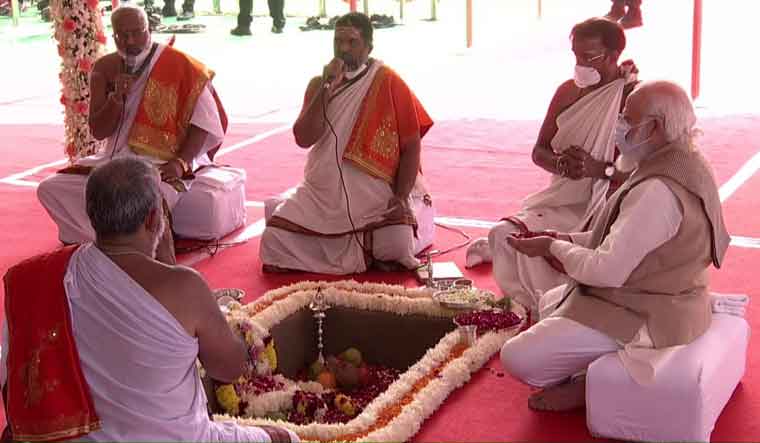Prime Minister Narendra Modi on Thursday laid the foundation stone for a new Parliament house, setting in process the construction of the building that forms a highlight of the ambitious and controversial Central Vista Project of the Centre.
A traditional 'bhoomi pujan' marked the groundbreaking ceremony for the new Parliament building, with Modi presiding over the ceremony, and it was followed by prayers performed by representatives from different religions.
In his speech at the ceremony, Modi described the occasion as a historic day and said it was an important milestone in the history of India's democracy. “What can be more beautiful or pure than that when we celebrate the 75th anniversary, we will draw inspiration from the new Parliament building,” he said.
also read
- PM Modi holds roadshow in Varanasi, to file nomination papers on Tuesday
- PM Modi's Patna roadshow: Route to traffic regulations, 5 things residents should know
- ‘No change in leadership; Modi will continue as PM’: Amit Shah on Kejriwal’s ‘retirement’ jibe
- Odisha polls 2024: PM Modi to address rallies in western districts on Saturday
“If the present building saw India becoming independent, the new building will witness India becoming 'atmanirbhar'. It should be a matter of pride for us that the new Parliament building is being built in independent India,” he said.
The new Parliament building, proposed to be four-storied, would be built in an area of 64,500 square metres at an estimated cost of Rs 971 crore. It is stipulated to be completed in time to commemorate India’s 75th Independence Day in 2022.
The project also involves providing each Member of Parliament a 40 sq m office space in the redeveloped Shram Shakti Bhawan, construction for which is slated to be completed by 2024.
The new Parliament building has been designed by M/s HCP Design and Management Pvt Limited Ahmedabad and the construction would be carried out by Tata Projects. The new building is to be equipped with all modern audio-visual communication facilities and data network systems.
Modi recollected the first time he entered Parliament after winning the Lok Sabha elections in 2014, saying he had bowed his head before the 'temple of democracy', and added that the present building was now proving to be inadequate to meet the needs of the changing times. “In the last few decades, we upgraded the building in keeping with the demands of the changing times. Walls were broken down to add new facilities. Now, this building is appealing for rest,” he said.
According to the government, changing times have also meant that future needs have to be borne in mind. The proposed New Parliament Building (NPB) will have a seating capacity for 888 Members in the Lok Sabha chamber with an option to increase it to 1,224 members during joint sessions. Similarly, the Rajya Sabha chamber would have a seating capacity for 384 members.
The 93-year-old Parliament house has many limitations with regard to modern communication, security and earthquake safety requirements, according to the Centre. There are also limitations to retrofitting the building. Consequently, necessary modifications cannot be made without causing damage to its structure and visage, states the government.
“The need for the new Parliament building has long been felt as the depth, scope, and complexity of legislative and parliamentary work have increased manifold over time. A number of members have over the years expressed the need for modern and hi-tech facilities to enable them to focus meaningfully on the needs of their constituents and address issues of public importance at the earliest,” said the government statement.
According to a statement released by the government, “India’s glorious heritage, too, will find a place in the new Parliament building. Artisans and sculptors from all over the country would contribute to and showcase India’s cultural diversity in the new Parliament building,” according to a government statement. “The new Parliament building would stand as a monument to Indian democracy and its people, showcasing not only our magnificent history, but also the strength, unity, diversity and industriousness of our people,” it said.
The project has been at the centre of a controversy, with critics questioning the need for spending on the construction of the building at a time when the country is battling COVID-19 and its economic impact. The opposition Congress criticised the prime minister for “building a palace” at a time when the farmers were protesting.
“Modi ji, it will be recorded in history that when our food providers were on the streets for 16 days fighting for their rights, you were, in the name of Central Vista, erecting a palace,” tweeted Randeep Surjewala, AICC Communications Department chairman.
The proposal for the new Parliament building was simultaneously made by Vice-President of India and Chairman, Rajya Sabha, M. Venkaiah Naidu and Lok Sabha Speaker Om Birla on August 5, 2019 in the Rajya Sabha and Lok Sabha respectively.
Environmentalists have raised the issue of damage to the flora of the Lutyens zone due to the Central Vista Project, of which the new Parliament building is a part of. The official stand is that special care is being taken to ensure all environmental safeguards are followed, including minimal disturbance to Parliament sessions during construction work.







